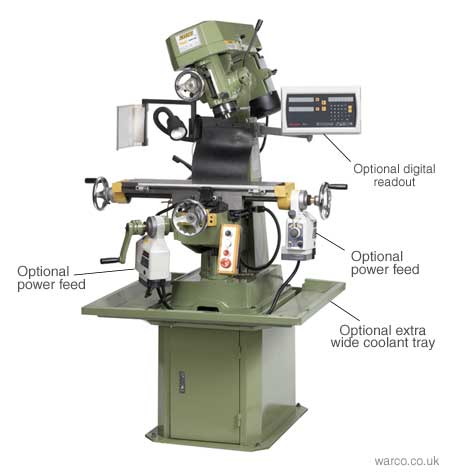Equipment/WarcoMill
Class Red equipment: Do not use without specific training.
(More about equipment classes)
Contents
Summary
The Warco mill can be used to machine objects from a wide range of materials. Training is required before members use the equipment because it is easy for users to damage it, and serious injuries, or fatalities, are possible. The machine has a table 660 x 152mm that can move 37cm in the X direction, 15cm in the Y and 34cm in the Z direction.
CURRENTLY THERE ARE NO TRAINERS FOR THE MILL.
Owners
- Diana Probst
- Mat Cook
- Roger Smith
Health and Safety
- Power supply to be disconnected when changing tools.
- All cutting tools to be kept in their holders until they are required.
- Waste material/offcuts to be kept clear of work area.
- Equipment will be checked for defects before each use to minimise the risk of possible electrical faults or fire.
- Carbon Dioxide extinguisher to be available for any electrical fires
- Eye protection to be worn when using the equipment.
- Risk assessment: https://docs.google.com/viewer?a=v&pid=forums&srcid=MDgwNzUyNzQ4MjA0NjE0MDY2NDIBMTU4NTI2NjEyMjIzOTU5MDkyODQBdmpubUpFanBkTklKATAuMQEBdjI
Training
THE MILL CAN CAUSE SERIOUS INJURY. ONLY APPROVED OPERATORS ARE PERMITTED TO USE IT.
To get the required training to become an approved operator please contact one of the owners.
The owners will help users make the best use of the mill but it must be emphasised that learning to take full advantage of all its capabilities takes months of practice. The owners have limited time so members will need to take responsibility for much of their own training. More details about the training can be found at
Instructions
The feeds and speeds spreadsheet introduced in training is available here.
Tips & Tricks
Use a conventional milling cut to get the part to approximately the final size. With a conventional cut the cutting surface and the work piece are moved in opposite directions. A climbing cut is where the cutting surface and the work piece are moved in the same direction. It produces a better finish but puts extra strain on the cutting tool AND IS MORE LIKELY TO BITE, TAKE UP THE BACKLASH, BITE FURTHER AND BREAK THINGS. Therefore only use conventional (opposing directions) cutting. (Climb cuts are only to be used for very small finishing pass operations, usually not in steel, where tool biting is not a concern).
When drilling, start with a spotting drill (centre drill at a push) to make sure that the hole starts exactly centre. It is usually OK to drill to a depth of 3 to 4 diameters in a single pass (less with a centre drill). After that withdraw the drill every diameter of cutting depth to clear the swarf. Use cutting fluid beyond a depth of about 2 diameters (and always in steel). Be aware that halving the diameter of a drill reduces its strength 8 fold. Small drills break very easily and broken tools present a hazard and are exceptionally difficult to remove. Much much less pressure is needed to drill small diameter holes. Use just enough pressure to create long curly chips. Look up the appropriate rotation speed for the drill. The Warco cannot spin fast enough for drills below about 2mm.
Maintenance
- Clean away all swarf at the end of a work session with a brush or vacuum. Do not blow because this can send chips where they can damage the machine. Bare hands are very easily injured by the sharp surfaces.
Further Information
Specification: [1]
Spindle: we have the 3MT spindle version. This is NOT compatible with the Super7/ML7 lathe headstock which is 2MT.
Current drawbar is 3/8.
